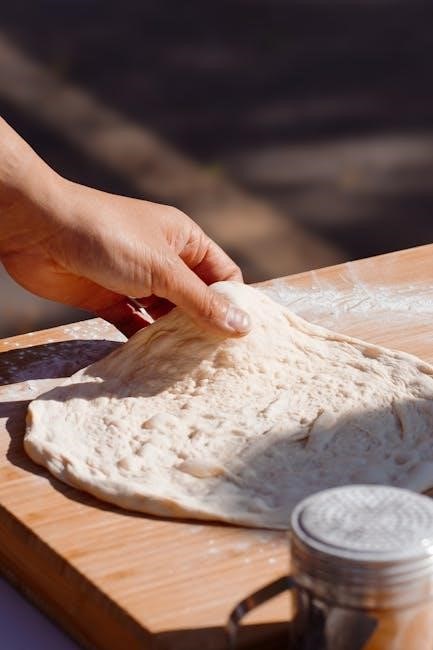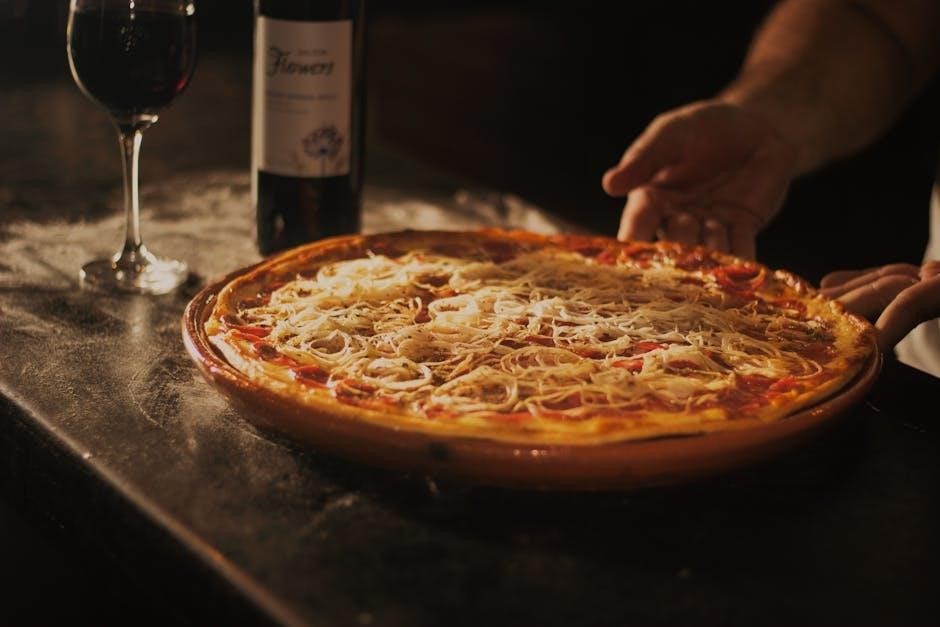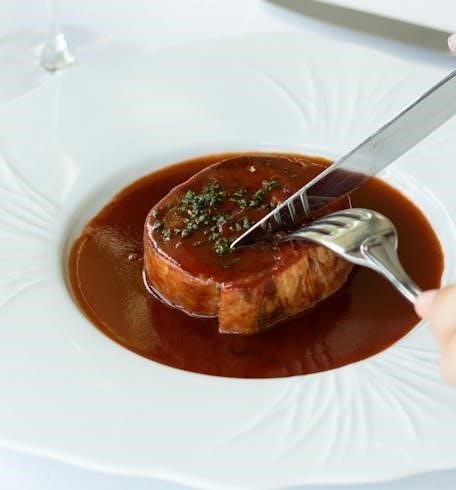Trader Joe’s pizza dough is a beloved convenience for home cooks, offering pre-made, easy-to-use options in varieties like regular, wheat, and herb-infused. Perfect for all skill levels, it simplifies pizza night with its soft, pliable texture and delicious flavor, inspired by traditional Neapolitan recipes.
Overview of Trader Joe’s Pizza Dough Varieties
Trader Joe’s offers a variety of pizza dough options to suit different tastes and preferences. Their lineup includes classic regular pizza dough, whole wheat dough for a nuttier flavor, and herb-infused dough for added aroma. Additionally, they feature a garlic and herb version, perfect for those who enjoy a savory twist. One of their unique offerings is a Neapolitan-style dough inspired by Italy’s famous pizza fritta, crafted by a supplier in Naples. Each variety is pre-made, fresh, and ready to use, making it easy for anyone to create delicious homemade pizza without the hassle of mixing and kneading from scratch.
Why Trader Joe’s Pizza Dough is Popular
Trader Joe’s pizza dough is a fan favorite due to its convenience, quality, and versatility. Pre-made and ready to use, it saves time while delivering a homemade pizza experience. The dough is soft, pliable, and easy to handle, making it accessible for all skill levels. Its popularity also stems from the variety of flavors, including classic, whole wheat, and herb-infused options, catering to diverse tastes. Many appreciate its ability to create a crispy crust or chewy base, depending on baking techniques. Plus, it’s inspired by authentic Neapolitan recipes, adding a touch of tradition to every pizza. Its ease of use and consistent results make it a staple for family pizza nights and quick meals.
Preparing the Dough
Preparation involves thawing the dough, letting it rest, and gently stretching or rolling it to your desired shape. This ensures the dough is pliable and ready for baking.
Thawing and Resting the Dough
Thawing the dough is essential for achieving the right texture and flexibility. The dough should be removed from the freezer and placed in the refrigerator overnight or left at room temperature for a few hours. Allowing it to rest is crucial as it relaxes the gluten, making it easier to shape. Once thawed, gently roll or stretch the dough to your desired thickness and shape, ensuring an even surface for toppings. Proper resting and thawing prevent tearing and ensure a smooth, even bake. This step is vital for achieving a crispy crust with a soft interior. Patience here pays off in the final result.
Shaping the Dough into a Pizza Crust
Shaping the dough into a pizza crust is a straightforward process that requires gentle handling to maintain its pliable texture. Start by lightly flouring your work surface and place the thawed dough in the center. Use your hands or a rolling pin to flatten and stretch the dough into your desired shape, whether round, oval, or rectangular. For a crispy crust, aim for even thickness, typically 1/4 inch. Sprinkle semolina or cornmeal on the dough to prevent sticking and enhance crispiness. If using a pizza peel or baking sheet, transfer the dough carefully to avoid tears. Gently stretch or toss the dough for a more rustic, hand-shaped crust. Avoid overworking the dough, as it can become tough. If the dough tears, patch it by pressing edges together. For a perfect circle, spin the dough on a floured surface. Remember, the key is to handle the dough gently to preserve its structure and ensure an even bake. Proper shaping sets the foundation for a delicious, evenly cooked pizza crust. Always ensure the dough is at room temperature before shaping for the best results. This step is crucial for achieving the desired texture and presentation of your pizza. By following these steps, you can create a crust that complements your toppings perfectly.
Oven Temperature and Preheating
Preheat your oven to 450-500°F for optimal results. A hot oven ensures a crispy crust. Use a pizza stone if available for enhanced crispiness and even cooking. Always preheat thoroughly before baking.
Recommended Oven Temperature for Baking
For the best results, preheat your oven to 450-500°F. This temperature range ensures a crispy crust and evenly cooked pizza. A higher temperature, closer to 500°F, is ideal for achieving a golden-brown finish; If using a pizza stone, place it in the oven while preheating to enhance crispiness. Allow the oven to preheat for at least 15-20 minutes before baking to ensure consistent heat distribution. Proper preheating is key to avoiding a soggy crust and achieving a perfectly baked pizza. Always refer to the packaging instructions for specific temperature recommendations, as slight variations may exist depending on the dough variety.
How to Preheat Your Oven for the Best Results
Preheating your oven is essential for achieving a perfectly baked pizza. Start by setting your oven to 450-500°F, depending on the dough variety. Allow the oven to preheat for at least 15-20 minutes to ensure it reaches a consistent temperature. For an extra crispy crust, place a pizza stone or baking steel inside the oven while it preheats. A preheated stone helps distribute heat evenly and absorbs moisture from the dough. Avoid opening the oven door during preheating, as this can lower the temperature. Once preheated, carefully place your shaped dough on the stone or a lightly oiled pan. Proper preheating ensures a golden, crispy crust and a well-cooked pizza every time.
Baking the Dough
Bake the dough in a preheated oven at 450-500°F for 6-15 minutes, or until golden and crispy. Use a pizza stone or steel for a crisper crust.
Pre-Baking the Dough Before Adding Toppings
Pre-baking the dough, also known as par-baking, ensures a crispy crust before adding toppings. Preheat your oven to 450-500°F (232-260°C). Place the dough on a lightly oiled pan or pizza stone. Bake for 5-10 minutes, or until the dough is lightly golden and set. This step prevents the crust from becoming soggy and helps the toppings cook evenly. For a crisper base, bake for an additional 2-3 minutes. Monitor the crust to avoid overcooking. Once pre-baked, remove the dough from the oven and add your desired sauce, cheese, and toppings before baking again until the cheese is bubbly and the crust is golden brown.
Baking Time and Temperature Guidelines
Bake Trader Joe’s pizza dough at 450-475°F (232-245°C) for optimal results. Preheat your oven with a pizza stone if desired for a crispy crust. Bake the dough for 6-8 minutes before adding toppings. After adding toppings, bake for an additional 7-10 minutes, or until the cheese is bubbly and the crust is golden. Rotate the pizza halfway through baking for even cooking. Keep an eye on the pizza after 8 minutes, as ovens vary. The total baking time typically ranges from 12-18 minutes, depending on your oven and crust preference. For a well-done crust, bake up to 20 minutes, ensuring the edges are golden and the center is cooked through.

Shaping and Stretching Techniques
Sprinkle semolina or cornmeal on your surface to prevent sticking. Gently stretch the dough by hand or with a rolling pin to achieve your desired shape.
Tips for Stretching the Dough Thin
To achieve a thin crust, ensure the dough is at room temperature and well-rested. Lightly flour or sprinkle semolina on your work surface to prevent sticking. Gently stretch the dough by hand, starting from the center and working outward. Use a gentle pressing motion with your fingertips to thin it further. For an extra-thin crust, try tossing the dough in the air or draping it over your knuckles to stretch evenly. Avoid overworking, as this can tear the dough. If using a rolling pin, roll in one direction only to maintain elasticity. For a crispy base, ensure the dough is evenly thin with no thick spots before topping.
How to Achieve a Perfectly Round Crust
A perfectly round crust starts with gentle handling of the dough. Ensure the dough is at room temperature and rested to improve pliability. To shape, place the dough on a lightly floured surface and press down lightly in the center with your fingertips. Use a rolling pin or your hands to evenly stretch outward, maintaining circular motion. For a uniform shape, toss the dough briefly in the air or drape it over your knuckles. Avoid overstretching, as this can cause unevenness or tears. Place the dough on a pizza peel or baking sheet, then gently pull and tuck the edges to form a perfect circle. Using a guide, like a plate or pizza stone, can also help achieve symmetry. Practice makes perfect for consistent results!

Adding Toppings
Add your favorite toppings to the dough, balancing flavors and textures for a delicious pizza. Keep it simple or creative—Trader Joe’s dough is versatile for any combination!
Choosing the Right Toppings for Your Pizza
Selecting the right toppings is key to a great pizza. Classic choices like tomato sauce, mozzarella, and fresh basil are timeless. Trader Joe’s offers a variety of pre-made sauces and cheeses that pair perfectly with their dough. For a vegetarian option, consider roasted vegetables or caramelized onions. Meat lovers can opt for pepperoni, sausage, or prosciutto. Don’t forget to balance flavors—sweet, salty, and savory elements create a harmonious taste experience. Let the kids get creative with their favorite ingredients, making pizza night fun for everyone. Remember, the dough is versatile, so feel free to experiment with unique combinations for a personalized masterpiece.
How to Spread Sauce and Cheese Evenly
Spreading sauce and cheese evenly is crucial for a perfect pizza. Start by applying a thin, uniform layer of sauce, leaving a small border around the edges to avoid sogginess. For cheese, sprinkle it evenly across the dough, ensuring good coverage without overloading. A mix of mozzarella and Parmesan works well for flavor and texture. If using multiple cheeses, layer them gently to maintain even melting. Avoid piling toppings too high, as this can lead to uneven cooking. Use a spatula or spoon to smooth out the sauce and spread cheese consistently. This ensures every bite is flavorful and well-balanced, making your pizza a delight to eat.
Advanced Baking Techniques
Elevate your pizza game with high-temperature baking, pizza stones, and outdoor ovens for a crispy, well-cooked crust and a smoky flavor, achieving restaurant-quality results.
Using a Pizza Stone for a Crispy Crust
A pizza stone is a key tool for achieving a crispy crust with Trader Joe’s dough. Preheat the stone in your oven at 450-500°F for at least 30 minutes. Dust the stone with semolina flour or cornmeal to prevent sticking. Place the shaped dough on the preheated stone and bake for 6-8 minutes. The stone absorbs moisture, creating a golden, crunchy crust. For an extra crispy texture, bake the dough alone for 2-3 minutes before adding toppings. This method ensures a restaurant-quality crust with minimal effort, enhancing the overall flavor of your homemade pizza.
Baking in an Outdoor Oven or Grill
Baking Trader Joe’s pizza dough in an outdoor oven or grill adds a smoky, authentic flavor. Preheat your grill or outdoor oven to its maximum temperature, ideally around 500-850°F. Place the dough on a lightly floured pizza peel or directly on the grill grates. Cook for 2-3 minutes per side, or until the crust is golden and crispy. For outdoor ovens, a preheated stone can enhance crispiness. Keep the lid closed to retain heat and ensure even cooking. Monitor closely to avoid burning, as high heat cooks the dough quickly. This method delivers a delicious, charred crust reminiscent of artisanal pizzas, perfect for outdoor gatherings or quick meals.
Cooking Time and Monitoring
Trader Joe’s pizza dough typically bakes in 6-12 minutes, depending on oven temperature and crust preference. Monitor for golden edges and bubbly cheese to ensure perfection.
How Long to Bake for Different Crust Preferences
Baking time for Trader Joe’s pizza dough varies based on crust preference. For a crispy crust, bake at 450-475°F for 6-8 minutes. A golden, well-done crust may take 8-10 minutes, while a softer crust requires 5-7 minutes; Keep an eye on the pizza during the last few minutes to avoid overcooking. If using a pizza stone, preheat it to ensure even cooking. Rotate the pizza halfway through for an evenly baked crust. Let the dough pre-bake for 2-3 minutes before adding toppings for a firmer base. Adjust time based on oven strength and desired crispiness for the perfect result every time.
Signs Your Pizza is Ready to Take Out
Your pizza is ready when the crust is golden brown, the cheese is bubbly and slightly caramelized, and the edges are crispy. For Trader Joe’s pizza dough, look for these signs: the crust will lift easily with a spatula, and the bottom will be golden when checked. If using a pizza stone, the crust should have a crispy texture. Avoid overcooking, as the crust can quickly go from perfectly golden to burnt. Once the cheese is fully melted and the toppings are heated through, remove the pizza from the oven promptly to prevent overcooking. Let it cool for a few minutes before slicing for the best results.

Freezing and Reheating
Trader Joe’s pizza dough can be frozen for later use. Thaw frozen dough in the refrigerator or at room temperature before baking. Reheat leftover pizza in the oven or microwave for a crispy texture and retained flavor.
How to Freeze Trader Joe’s Pizza Dough
Freezing Trader Joe’s pizza dough is a convenient way to preserve it for future meals. Start by dividing the dough into desired portions, such as individual balls or rolls. Wrap each portion tightly in plastic wrap or place it in an airtight freezer bag to prevent freezer burn. Label the packages with the date and contents for easy identification. Store them in the freezer at 0°F (-18°C) for up to 3-4 months. When you’re ready to use the dough, simply thaw it in the refrigerator overnight or leave it at room temperature for a few hours. This method ensures the dough remains fresh and ready for baking whenever you need it.
Reheating Leftover Pizza for Maximum Flavor
To reheat leftover pizza made with Trader Joe’s dough, preheat your oven to 425°F (220°C). Place the pizza slices on a baking sheet lined with parchment paper, ensuring they don’t overlap. Bake for 8-10 minutes, or until the crust is crispy and the cheese is bubbly. For an extra crispy crust, broil for an additional 1-2 minutes. Alternatively, use a skillet on medium heat for 2-3 minutes per side. Avoid using the microwave, as it can make the crust soggy. Proper reheating restores the pizza’s flavor and texture, ensuring each bite tastes as fresh as when it was first baked.

Tips and Tricks
Preheat the oven to 450°F for crispy crusts. Use a pizza stone for added crunch. Don’t overload with toppings—let the dough breathe. Monitor closely to avoid burning.
Common Mistakes to Avoid When Baking
Avoid overloading the dough with too many toppings, as this can make the crust soggy and uneven. Ensure the oven is preheated to the correct temperature (typically 450-500°F) for a crispy crust. Don’t skip the step of letting the dough rest after thawing, as this helps it stretch smoothly. Handle the dough gently to prevent tears. Overworking the dough can lead to a dense texture. Use a pizza stone if possible, but lightly dust it with flour or cornmeal to prevent sticking. Lastly, don’t open the oven too early, as this can cause the dough to sink. Monitor closely to achieve the perfect bake.
How to Fix a Tear in the Dough
If the dough tears while shaping, don’t panic! Gently press the dough together at the tear, ensuring it seals evenly. Let the dough rest for a few minutes to relax the gluten, then retry shaping. To strengthen the area, dab a small amount of water or olive oil on the tear and press the edges firmly together. Sprinkle a pinch of flour on the dough to prevent sticking. Work gently to avoid creating more tears. If the tear persists, you can still bake the dough as is—it will hold up in the oven. Keep the dough at room temperature for better pliability and easier repair.
Alternative Uses for Pizza Dough
Trader Joe’s pizza dough is incredibly versatile beyond making pizza. Try using it for garlic knots by cutting the dough into small pieces, rolling them in garlic butter, and baking until golden. It’s also perfect for homemade breadsticks—simply shape, brush with olive oil, and sprinkle with herbs. For a sweet treat, transform the dough into cinnamon rolls by rolling it out, spreading butter and cinnamon sugar, then rolling and slicing. You can even use it as a base for flatbread sandwiches or stuffed bread. The dough’s pliable texture makes it ideal for creative recipes, allowing you to experiment with both savory and sweet dishes effortlessly. Get creative and enjoy!
Trader Joe’s pizza dough simplifies pizza night with its ease of use and versatility. Perfect for all skill levels, it ensures delicious results every time. Enjoy experimenting!
Final Thoughts on Using Trader Joe’s Pizza Dough
Trader Joe’s pizza dough is a game-changer for home cooks, offering convenience without compromising flavor. Its pre-made, versatile options cater to all skill levels, making pizza night effortless. Whether you’re a novice or an experienced baker, the dough’s soft, pliable texture ensures delicious results. Inspired by traditional Neapolitan recipes, it brings authenticity to your creations. With proper thawing, preheating, and baking techniques, you can achieve a crispy crust and perfectly cooked toppings. The dough’s adaptability allows for endless customization, from classic margherita to gourmet combinations. Embrace the simplicity and enjoy experimenting with Trader Joe’s pizza dough for a memorable culinary experience.
Encouragement to Experiment and Enjoy
Trader Joe’s pizza dough invites creativity and experimentation, offering endless possibilities for toppings and techniques. Try unique combinations like fig jam and prosciutto or classic pepperoni for a personalized touch. Don’t be afraid to explore different baking methods, such as using a pizza stone or grill for a crispy crust. The dough’s versatility also extends beyond pizza—use it for garlic knots, breadsticks, or even cinnamon rolls. Embrace the fun of cooking and make each pizza night an opportunity to innovate and savor delicious, homemade meals with family and friends. Let your imagination run wild and enjoy the process of crafting your perfect pie!



